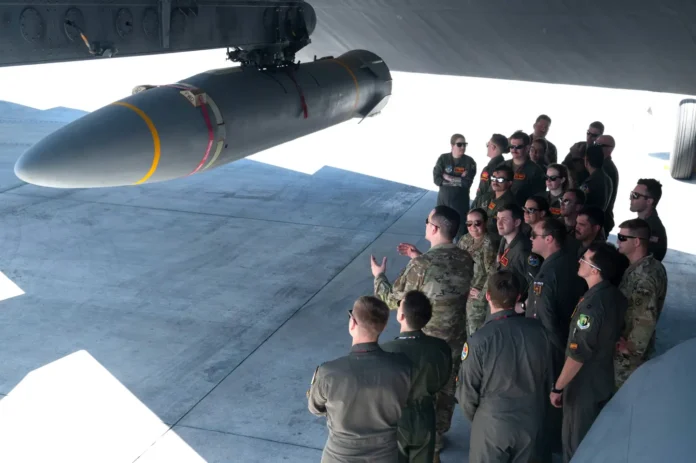In a move laden with geopolitical symbolism, the United States Air Force successfully test-fired a cutting-edge hypersonic missile over the Pacific Ocean on March 17th, a bullish statement of resolve as Washington races to keep up with Beijing and Moscow’s rapidly accelerating programs.
The trailblazing trial, conducted at the Reagan Test Site on the remote Kwajalein Atoll, saw a B-52 Stratofortress bomber based at Andersen Air Force Base on the U.S. territory of Guam unleash a prototype of the advanced AGM-183A Air-Launched Rapid Response Weapon (ARRW).
Streaking at a top speed exceeding Mach 5—over 3,800 mph or around 6,100 km/h—the ARRW is among the latest additions to the Pentagon’s still relatively nascent arsenal of hypersonic boost-glide weapons. These revolutionary munitions can deliver conventional payloads to time-sensitive targets by combining the speed of a ballistic missile with the maneuverability and terrain-hugging approach of a cruise missile.
While the U.S. military remained predictably tight-lipped regarding detailed performance data from the landmark Pacific test, Air Force spokesperson Melissa Anderson confirmed the prototype weapon “performed as intended” during the historic flight from Guam to Kwajalein.
“The Air Force gained valuable insights into the capabilities of this new, cutting-edge technology,” Anderson added in a statement. “The successful test improved our test and evaluation capabilities for continued development of advanced hypersonic systems.”
Yet this seminal demonstration of American prowess in an increasingly pivotal warfare domain came with an undeniable geopolitical subtext.
With China already deploying an expansive suite of hypersonic glide vehicles designed to penetrate sophisticated U.S. missile shields, the ARRW test amounted to Washington’s latest bid to avoid being comprehensively outmatched by a near-peer military titan.
“This test is intended to signal staunch U.S. commitment to deterring an increasingly assertive China in the Pacific region,” said Matthew Kroenig, deputy director of the Atlantic Council’s Scowcroft Center for Strategy and Security. “Beijing might have a temporary lead, but the Pentagon will leverage America’s dynamic innovation base to preserve its qualitative military edge.”
Beijing’s rapid development of hypersonics since 2014, accelerated by successful tests of nuclear-capable glide vehicles and other game-changing prototypes, has raised alarm bells across the U.S. defense community.
Similarly, Russia’s brazen deployment of Zircon hypersonic cruise missiles against Ukraine has underscored the battlefield implications of a technology designed to handily defeat traditional air defenses.
Craig Singleton, a senior China fellow at the Foundation for Defense of Democracies, argues the Pacific trial represents a blunt message from the Biden administration that it will not cede this critical realm to strategic rivals without a vigorous fight.
“While no panacea, this visible test of U.S. hypersonic capabilities reaffirms Washington remains a formidable contender committed to the arduous task of matching stride with Beijing and Moscow’s hypersonic trajectories,” Singleton told reporters.
Yet the ARRW program’s future remains clouded by uncertainty amid budgetary pressures and skepticism from some lawmakers and Air Force brass over the weapon’s operational utility.
During congressional testimony last March, top Air Force officials confirmed there were no firm plans to transition the experimental ARRW design into a program of record, raising the specter of imminent cancelation.
While the service’s initial fiscal 2024 budget proposal sought $150 million for ARRW procurement, legislators ultimately stripped all related funding from the final National Defense Authorization Act.
Senior Pentagon officials now say continued ARRW production will hinge on a thorough assessment of data from not just the March 17th trial, but a series of increasingly complex test flights dating back to late 2022.
Gen. Duke Richardella, the Air Force’s deputy chief of staff for operations, told the House Armed Services Committee just last week that “future ARRW production decisions are pending final analysis of all flight test data.”
For critics of the program, such hedging reflects deeper institutional skepticism over ARRW’s near-term operational viability relative to other, more mature hypersonic projects like the service’s Air-Launched Rapid Response Weapon Operational Missiles (ARRW-OM) program.
Yet if the recent Pacific test confirmed ARRW’s basic design while identifying manageable areas for refinement, a temporary reprieve—or even resurrection—could be on the horizon.
“Sunday’s momentous trial injected fresh momentum into the push to field a credible air-launched hypersonic deterrent,” said Kroenig. “It would be imprudent for Pentagon planners to terminate ARRW arbitrarily without a painstaking review of all data.”
Indeed, scrapping ARRW before exhausting all development avenues could ultimately undermine the program’s core mission: providing U.S. warfighters with a rapid-reaction deep-strike capability impervious to advanced Russian and Chinese integrated air defense systems.
“Dismissing hypersonics as a peripheral capability would gravely underestimate their disruptive impact on future battlespaces,” cautioned Singleton. “The Pentagon has finally awoken to hypersonics being a supreme litmus test for preserving American dominance and deterring great power aggression. That lucidity cannot be allowed to fade.”
In the absence of comprehensive, unvarnished test data from Kwajalein, however, the Pentagon’s path ahead on ARRW remains shrouded in uncertainty—emblematic of America’s broader struggle to avoid being eclipsed by rivals in this critical frontier of cutting-edge warfare.
While a single research program’s fate may seem relatively inconsequential, the March 17th Pacific test highlighted the enormity of what is truly at stake as U.S. officials grapple with a rapidly evolving hypersonic balance-of-power.
As Kroenig soberly concluded: “Hypersonics are no longer some abstract, theoretical concern for Pentagon war-gamers. They are here, they are real—and their proliferation among potential U.S. adversaries could fundamentally undermine America’s global force projection capabilities and credible deterrent posture.”
“Failure to urgently embrace hypersonics as the preeminent military frontier of the 21st century could catalyze the very miscalculation or aggression that U.S. forces exist to prevent.”





















